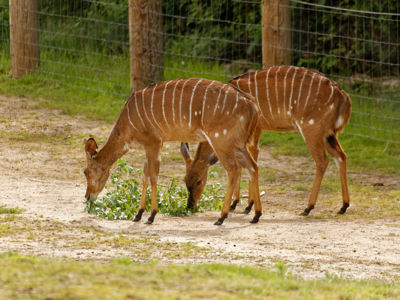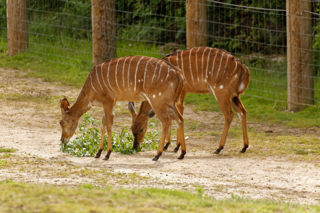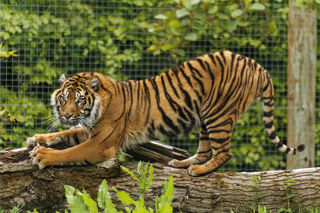
Nyala
Nyala are a medium sized antelope that exhibit high sexual dimorphism (where the male and female look very different). The male has two long manes; one down his back and one from his chin to his stomach. The males vary in colour from a light chestnut to a chocolate-brown that darkens with age. They have an average of 14 white stripes across their back. The female nyala is much smaller with a bright chestnut-brown coat. Both sexes are very alert to danger with the female using a sharp, high warning bark.

Nyala are mainly active during the day and are found in pairs or small groups of between 3-15 individuals. Mating happens mostly during the Spring and Autumn when bull and ewe herds come together. Herds will also join together temporarily at watering holes and feeding grounds. Adult bulls will often become solitary but can be seen along side other game species like the kudu, waterbuck and impala. Their diet mostly consists of grasses fruits and flowers.

Nyala are classified by the IUCN as Least Concern. However, the population does come under threat from habitat loss due to agriculture and cattle grazing. They are also hunted for food and for their skin.
Key Facts:
Conservation Status: Least Concern
Distribution: Malawi, Mozambique, South Africa, Swaziland and Zimbabwe. Introduced to Botswana and Namibia
Habitat: Dense thickets, lowland forests and dry savannah woodlands, generally near water
Diet: Herbivorous (mainly fruit, grass, flowers and browse)
Height: Bull 104-121cm, ewe 82-106cm
Weight: Bull 92-126kg, ewe 54-68kg
Gestation: 7 months
No. of young: 1
Life span: 19 years

SUPPORT OUR ANIMALS
If you're looking for an alternative way to donate to Twycross Zoo, you can help support our animals and our zoo keepers by purchasing something from our Amazon Wishlist!
Updated regularly by our zoo keepers, the items on the list help to provide enrichment for our animals and keep their habitats well maintained.
Every donation helps us as a conservation charity.

